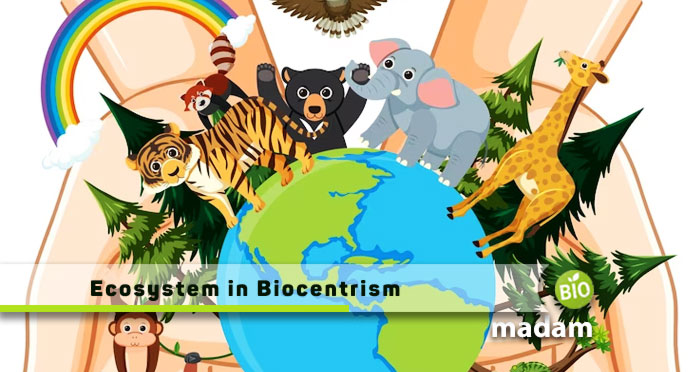All the habitats, biomes, and ecosystems are important to life on Earth. Many biological studies give significant importance to these natural circles playing a crucial role in building up life. However, theories like biocentrism and anthropocentrism do not consider environmental elements an integral part of life. They believe that living organisms are the most critical components of life. However, we cannot deny the vitality of the ecosystem and non-living elements in our surroundings. So, what is an ecosystem in biocentrism?
This article tells you everything about how ecosystems and biocentrism are related, along with the significance of ecosystems.
What is Ecosystem?
Ecosystem refers to organisms living in a geographical region and interacting with the environment. They are the building units of biospheres.
Sir Arthur George Tansley, an English botanist, introduced the concept of the ecosystem in biology. He explained the importance of the interactions among microorganisms and organisms and how they interact with the non-living environment.
The study of ecosystems involves living components of the system like plants, animals, fungi, etc. At the same time, the non-living components include Earth, soil, sun, climate, weather, etc. Nutrient cycles and energy flows link the living and physical components, making them inseparable.
Ecosystems are categorized into various types based on their types. Biomes are the largest ecosystems, while micro-ecosystems are as small as ponds and puddles.
Before we study what is an ecosystem in biocentrism, here’s a quick sneak peek into biocentrism.

What is Biocentrism?
Biocentrism is a theory proposed by Robert Lanza in his book, “Understanding the Universe’s True Nature Through Life and Consciousness.” He put biology above all other disciplines of science.
The word ‘biocentrism’ comprises ‘bio’ meaning life, and ‘centrism’ indicating center. Thus, biocentrism puts life at the center of everything. Lanza explained that the universe exists because of our consciousness. Subsequently, the universe came into being to facilitate life and not vice versa.
However, biocentrism does not believe that humans are higher than any other species, unlike anthropocentrism. Yet, it also does not give the same significance to the ecosystem as ecocentrism. Biocentrism places living organisms on a high pedestal, ignoring the importance of the non-living components of the ecosystem. Ecosystems play a major role in food chains and food webs by providing nutrients to produce food.
Let’s tell you the role of the ecosystem in biocentrism.
What is Ecosystem in Biocentrism?
Some scientists and biologists believe that two separate moral concerns drive biocentrism, including organism-based and nature-based approaches. When the focus is on the equality of different organisms living in an ecosystem, it might ignore the value of environmental factors. However, the other approach focuses on upholding the purity of the environment, functioning on a systemic level rather than caring for specific entities only.
Biocentrism also requires an adequate environmentalist attitude to protect the environment while caring for living organisms. Adopting an environmentalist approach will allow us to preserve nature by avoiding deforestation and minimizing the use of leather and fur. It will also help control global warming by ozone layer depletion due to greenhouse gas emissions and other issues.

The Ethics of Respect for Nature
Paul W. Taylor wrote in his essay, “The Ethics of Respect for Nature,” that the system of ethics must protect everything in nature. He encourages biocentrism as it gives equal importance to humans and other living organisms. Yet Taylor also mentions that we must protect all life in nature, not only living organisms.
He has mentioned his four main ideas of biocentrism as follows:
- Humans are members of the Earth’s community, just like other organisms.
- Thus, humans do not hold any intrinsic value regarding an ethical system.
- Every organism is a teleological center of life that pursues its benefits in unique ways.
- The Earth’s ecosystem comprises a complex web of interconnected living and non-living elements.
Tailor mentions that we must realize how impacting one part of the food web can affect the others. He furthermore states that humans having the ability to make better decisions for themselves does not allow them to harm other ecosystem elements. While urbanization apparently benefits humans, it creates problems in the ecosystem as a whole. So, we must try to protect all parts of the ecosystem as they have an equal value.
Biocentrism Vs. Ecocentrism
Compared to biocentrism, ecocentrism focuses on all aspects of the ecosystem, including the biotic and abiotic components. An ecocentric approach includes abiotic factors like forests, rivers, oceans, wetlands, sunlight, etc. Ecocentrism does not put living organisms, particularly humans, on a higher level than anything else in the ecosystem. An ecocentric approach believes all ecosystem elements have equal importance regarding life. Examples of ecocentrism include eliminating CFCs to improve air quality and taking measures to save an endangered plant species.
The Bottom Line
Biocentrism and ecosystems must go hand in hand to ensure all organisms’ welfare and protect the environment. Typically, biocentrism does not mainly focus on the abiotic factors of our surroundings, which was one of the many reasons why biocentrism was debunked. However, when combining it with the ecosystem, sustainability increases. Nutrient cycles and energy flows link the living and physical components, making them inseparable. Preserving the non-living components also contributes to the welfare of living organisms.
FAQs
What are the main ideas of biocentrism?
Biocentrism mentions that all organisms are equal and inter-linked. Humans are in no way better than other living organisms. At the same time, Lanza also mentions that time is an absolute entity while life is infinite. Biocentrism explains that our consciousness shapes the universe and not vice versa.
What is the biocentrism theory of everything?
The biocentrism theory of everything refers to explaining life by combining biology and physics in one place. It does not separate the domains; instead, it mentions how both are essential to explaining the existence of life.
What does biocentrism value the most?
As the bio in biocentrism indicates, this approach values life the most. It promotes methods and thought processes that lead to the welfare of biotic elements of the ecosystem. It focuses on reducing urbanization, deforestation, and the use of fur and leather. Biocentrism says that all organisms are equal and must be cared for instead of only humans.
What are the 4 duties of biocentrism?
Biocentrism is based on four basic human responsibilities that contribute to all living organisms’ welfare. They include noninterference, non-maleficence, restitutive justice, and fidelity. Non-compliance to these results in drastic impacts on the ecosystem as a whole.

Jeannie has achieved her Master’s degree in science and technology and is further pursuing a Ph.D. She desires to provide you the validated knowledge about science, technology, and the environment through writing articles.

